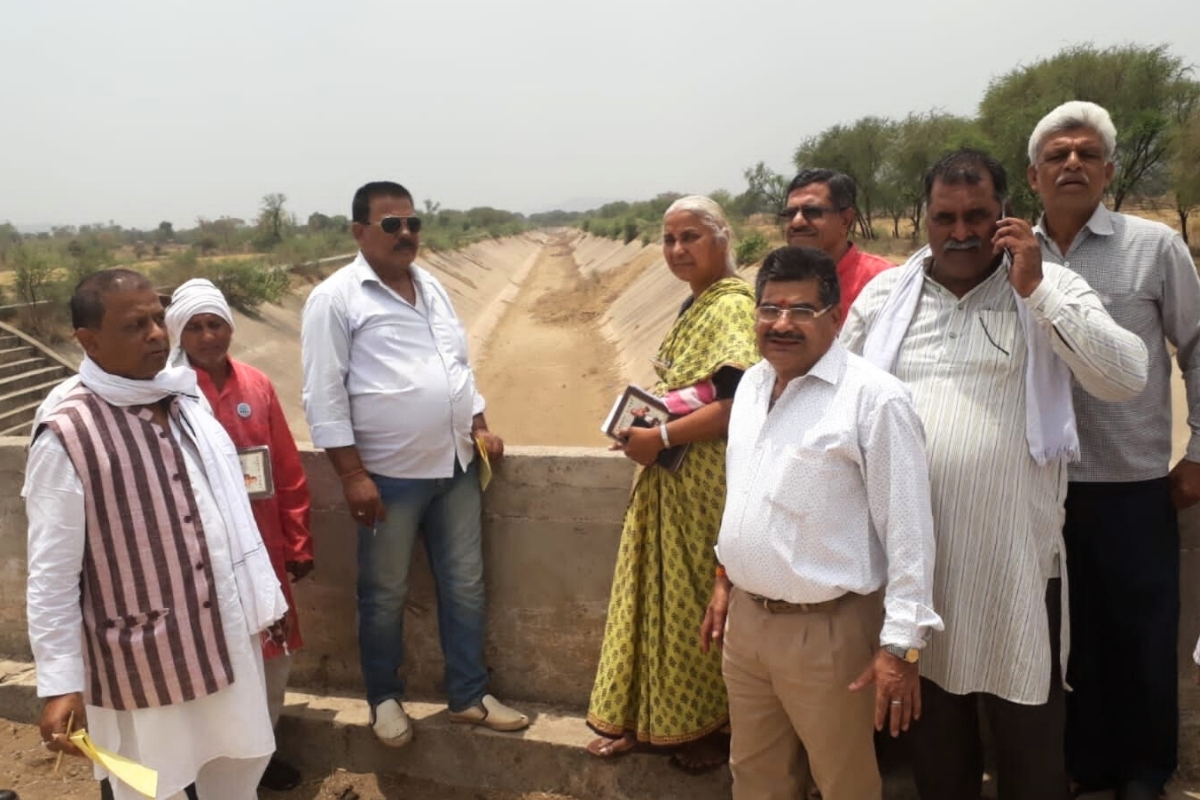On February 15, 2025, news broke that the historic spring at the famed Achabal Mughal Garden, in Anantnag, Kashmir, had dried up for the first time in history. This happened because of an unprecedented dry spell and minimal rainfall this winter. A day later, a video of 80-year-old Saja Begum went viral. In a dramatic show of emotions, she pleads, “Oh, beloved spring, what have we done to you? You have stopped giving us water. Let the spring come back to life. Let it overflow once more.” “Oh divine spring, why have you stopped giving us water? What have we done to you? … Come back to life… Oh Allah, let the water gush forth once more.”
Similarly, Yaskeena Khatana stands outside her small mud house in Chattergul, a village nearly 40 km from Srinagar, the capital of Jammu and Kashmir. She holds a metal pot, but there is no water to fill it. She looks at the hills where the spring once flowed. It was mid-February when we spoke to her. Yaskeena wiped her face and looked up at the sky, with only a few clouds, and the heating sun. She said,
“Our water source is silent, and our crops are fading away. We long for the days when water flowed freely, bringing life to our fields… Our fields suffer, our maize, and our animals go thirsty. The lifeline of our village is gone, and we are left to struggle.”

On 22nd February, the long-awaited rain and snowfall brought much-needed relief to the region, refilling several drying water bodies, including the Achabal spring. The spring, located in a historic 17th-century garden built by Mughal Emperor Jahangir’s wife, provides drinking water to 20 nearby villages. The water is now flowing as before. But while this spring has come back, many others in Kashmir are still drying up or have disappeared.
The Kashmir Himalayas are blessed with thousands of freshwater springs. Out of 6553 villages in Jammu and Kashmir, about 3313 villages have springs in their vicinity, i.e., 50.6% of the villages. However, more than 100 springs are near mining units in the region. Locally, in Kashmiri, known as nag or naag, these freshwater springs have played a crucial role in providing drinking water and irrigation. However, in the last two decades, studies show that over half of these water sources have either disappeared or shrunk significantly.

They are drying up because of less snowfall, rising heat, and unchecked construction. Apart from spring flow, this impacts the quality of water as well. Experts say if this continues, the region could face a big water crisis. In the village of Padabal, which is surrounded by glaciers and the Sindh River, for four months people relied on water tankers. Moreover, the daily chores of fetching water become an arduous task, particularly for Gujjar and Bakarwal women in the far-flung villages of Kashmir, as they have traditionally borne this responsibility. This isn’t just happening in my village—it’s the story of the entire Kashmir Valley.
“While the late snowfall has provided short-term relief, the real concern lies in the rising temperatures and the shrinking winter season,” said Dr. Haroon Rather, an environmental scientist based in Srinagar. “In the past decade, we’ve seen a pattern of less snowfall and higher temperatures, which results in less snowmelt in spring and summer.”
Earlier, in Padabal, Cherwan village—Ganderbal District—there were 10 springs recharged by the river’s underground water channels. Now, only one spring remains, which is shared between two villages, Padabal and Cherwan. Locals said that the reduced access to water for irrigation impacts their crop yields and, in turn, their food security.
Sami Ullah Bhat, a senior assistant professor at the University of Kashmir. “There are numerous examples throughout Kashmir,” he said. “In my own village, Kokergund Yaripora Kulgam, I remember 5-6 springs that existed 30 years ago, but they have now completely disappeared.” His research focuses on the ecological impact of these changes on Kashmir’s water systems and biodiversity.
Apart from water, dust from mining and crushing settles on the plants and vegetation, blocking and damaging their internal structures, and abrasion of leaves and cuticles. This, in turn, has an impact on the agricultural yield. In early 2025, Kashmir experienced a 79% rainfall deficit, leading to fears of negative impacts on the horticulture sector, potential forest fires, and drying lakes.
Dr. Rather stressed that current water management is not prepared for these changes. “We need a shift in policy,” he said. “Efficient irrigation, rainwater harvesting, and drought-resistant crops must be promoted to secure our water future.”

Scientists tested the water quality of 258 springs in the Kashmir Valley, including those mentioned, revealing that 39.5% have excellent water quality, 47.7% are classified as good, 5% are poor, 1.6% are very poor, and 6.2% are unfit for drinking. These springs provide vital fresh water for both people and nature.
No Snowfall
Lateef Khatana, an old man in his 80s, lives in Hayan, a village 50 km from the Srinagar summer capital of Jammu and Kashmir, on the left side of the link road connecting nearby areas. He sits outside his small house on a wooden bench. He said, “We used to drink from the spring all year, but for the last eight years, it disappears every summer.”

He shakes his head and sighs. “Now, the snow melts too fast, the land is dry, and the water is gone before we know it.” He doesn’t understand the science of climate change, but quite confidently states his observations, which are in fact correct.
Rising temperatures and an 80% drop in snowfall this winter have caused streams and rivers, including the Jhelum, to face severe water shortages. Media reports say about 65% of the region’s water sources are disappearing, making the situation worse. Satellite images show that snow cover is shrinking and glaciers are retreating—both of which are essential for keeping Kashmir’s water bodies, including springs. Recently, the lack of sufficient snowfall also led to the postponement of the national winter games in Gulmarg, a notable tourist resort.
Dr. Mukhtar Ahmad, Director of the Meteorological Department (MeT) in Srinagar, explained the changes in the precipitation pattern. In the 1980s and 1990s, late autumn and early spring used to bring snowfall, but now it mostly comes as rain. Winter has also become shorter, lasting only from December to January, whereas earlier, it stretched from October to March.
The study found that glaciers in Kashmir have shrunk by 28.82% over the past four decades. The glacier loss in this region is higher than in other parts of the Himalayas, with the Sind watershed experiencing the most melting.
Big Picture
India is home to around 5 million springs, with nearly 3 million in the Himalayan region alone. These springs provide drinking water to over 200 million people. In Kashmir, rural populations heavily rely on them, yet they remain largely unprotected. The lack of proper management and conservation efforts has left them vulnerable to pollution and overuse. For instance, the Veshav River, a major tributary of the Jhelum, is home to various trout species, and its ecosystem is under threat due to reduced water flow.
The springs in the Indian Himalayan Region (IHR) feed into the country’s major rivers, providing up to 90% of the water flow. When springs dry up, these rivers receive less water, leading to water shortages. This is happening across the region, from Jammu and Kashmir, Uttarakhand, to Sikkim, with many areas seeing a significant decrease in functional springs over the years.

Earth’s temperature has increased by 1.5°C in the past 50 years, and the Himalayan region is feeling the impact first. Scientists predict that temperatures in the Himalayas could rise by up to 6°C in the coming decades, which could severely affect glaciers, rivers, drinking water supply, and agriculture.
Kashmir’s water crisis is a growing concern that affects both people and the environment. Once abundant, the region’s natural springs are now drying up due to climate change, deforestation, mining, and unplanned development. This has led to water shortages, making life harder for farmers, villagers, and communities that rely on these springs for drinking water and irrigation.
Saja Begum sits on a stone near the Achabal spring, watching the water flow once more. She dips her fingers, smiles, and says, “You have returned, but for how long?”
While some springs, like Achabal, have come back to life after the rains, many others remain dry. People in the region wait and hope, but the changing weather and disappearing water sources make the future uncertain. Without action to protect these springs, life in the valley will only get harder. The people of Kashmir have always depended on these waters, but now, they are left asking—will the springs ever return?
Support us to keep independent environmental journalism alive in India.
Keep Reading
California Fires Live updates: destructive wildfires in history
Hollywood Hills burning video is fake and AI generated
Devastating wildfire in California: wind, dry conditions to blame?
Los Angeles Cracks Under Water Pressure
From tourist paradise to waste wasteland: Sindh River Cry for help
Follow Ground Report on X, Instagram and Facebook for environmental and underreported stories from the margins. Give us feedback on our email id greport2018@gmail.com.
Don’t forget to Subscribe to our weekly newsletter, Join our community on WhatsApp, and Follow our YouTube Channel








